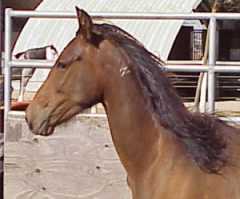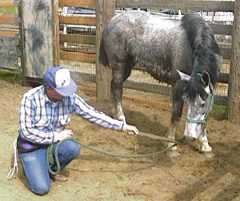Horse Training Mythbusters
|

|
|
|
|
The lowered head.
Head carriage (elevation) can be a fairly good indicator as to how "on alert" or how stressed a horse might be. A high headed horse is usually one ready to take some kind of action (flight or fight.) There is an axiom that states that the lower a horse holds his head, the more relaxed he is. This may be true to a point. We often ask new horse handlers to observe and compare how high the horse is holding his head as they engage in training activities, the object being for them to get the horse to respond without increasing his anxiety level, and more desirably, work the horse and have his anxiety level actually decrease during those activities. There is a point where a stressed horse may drop his head and simply "tune out." In our experience this is indicative of total stress overload. Instead of taking flight or engaging in a fight, the horse simply checks out. Some horses seem to be more prone to this behavior than others. Again, the horse's entire presentation will help provide clues as to what a particular horse's head posture means. Is the raised head due to stress or curiosity? Is the horse's head lowered because he is relaxed or is the head lowering an extreme gesture that suggests avoidance or just "checking out?" In any event a "level head" is generally the most desirable posture with ears moving, eyes alert and a reasonably relaxed neck and jaw.
|
This horse displays intense stress in his extreme head stance which is also accompanied by rigid eyes, ears and jaw.
|
Please note that this feature is still under development and is incomplete until such time as this notice is removed.
Return to Part Three
These books are available at reasonable prices through the LRTC Wild Horse Store.
Press "Back" to return to the page that brought you hereGo to Case Study SectionReturn to Training SectionReturn to Wild Horse MentorsReturn to KBR World of Wild Horses and BurrosGo To
|


